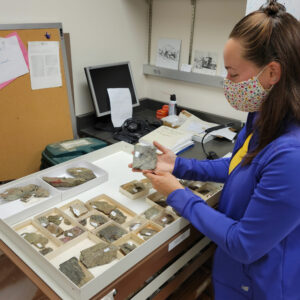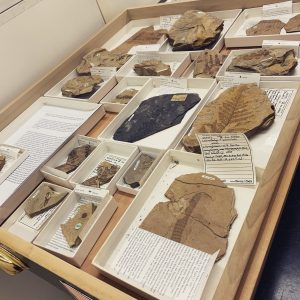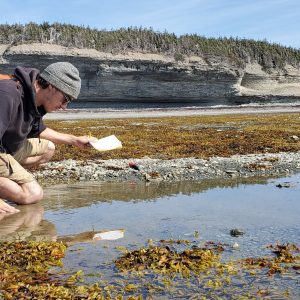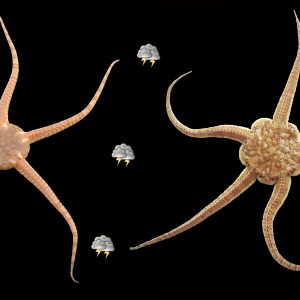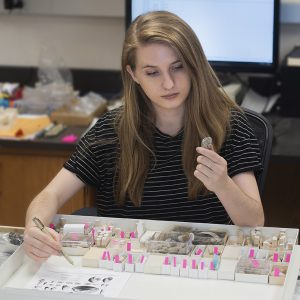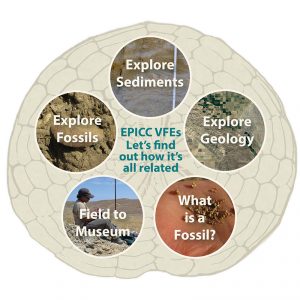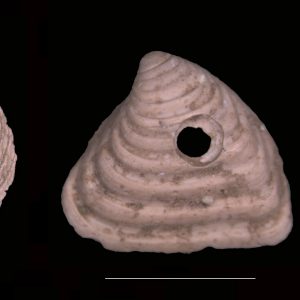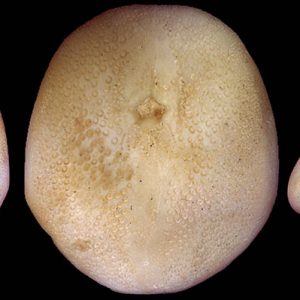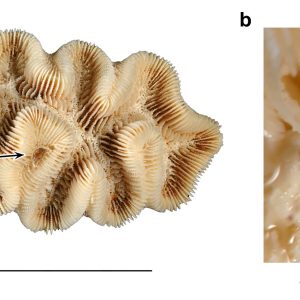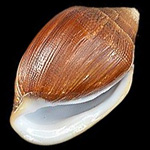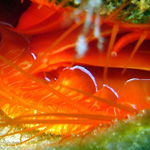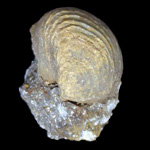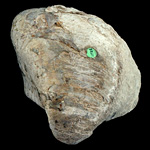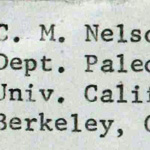Greeting you at the entrance of the University of California Museum of Paleontology (UCMP) is the ever-charismatic Nation’s T. rex, immediately grabbing your attention and drawing you in. Within the UCMP collections area your eyes dart to extinct marine reptiles lining the walls, plant fossils in the aisles with leaves larger than your torso, and woolly mammoth skulls tucked between cabinets. As a vertebrate paleontologist I’m captivated by these grand fossils, making it easy to overlook the … [Read more...] about Forgotten Fossils
Back to the Devonian for the Pteridophyte Collection Consortium (PCC) project
During the summer of 2019 we (graduate students Mackenzie Kirchner-Smith and Ixchel Gonzalez-Ramirez) spent a month working in the Paleobotanical Collections of the National Museum of Natural History (NMNH) in DC as part of the NSF-sponsored Pteridophyte Collection Consortium project (PCC). This project, led by PIs Carl Rothfels, Diane Erwin and Cindy Looy, seeks to digitize more than 1.7 million modern and fossil pteridophyte specimens. During the month at the NMNH we digitized more than 700 … [Read more...] about Back to the Devonian for the Pteridophyte Collection Consortium (PCC) project
Reading Between the Rocks: The Return to Anticosti
Having the opportunity to return to a field site is, in many ways, like rewatching a favorite movie series. On your first pass through, everything is unexpected and unfamiliar. For some movies, the amount of information and detail can be overwhelming. On your second pass through, even though you now know the characters, the setting, and the plot, you begin to notice important details that you missed the first time. Each time you rewatch the series, you discover new things and form new ideas, and … [Read more...] about Reading Between the Rocks: The Return to Anticosti
How often does extreme competition occur between species on the ocean floor?
Look around in nature or even in the city and you will see that organisms are not static entities, but interact with one another. Think of a robin with a worm in its beak, a tick crawling on your leg looking for a spot to puncture your skin, or two bucks fighting during the rutting season for the right to mate. The sea floor is also a place where animals search or fight for food to stay alive. On the continents, food is not unlimited; every individual tries to collect a piece of the pie (Fig. … [Read more...] about How often does extreme competition occur between species on the ocean floor?
UCMP now has over 100,000 cataloged invertebrate specimens
Thanks to our recent digitization projects, UCMP now has topped 100,000 cataloged invertebrate specimens! At least 6500 of these are fossil insects, millipedes and spiders digitized by Dr. Diane Erwin and undergraduate students under Berkeley's Fossil Insect PEN. Helping make all this possible was the work by the following participants: Dr. Marwa Wafeeq Abdelkhaliq Ibraheem (Ain Shams University, Egypt; volunteer), graduate students Winnie Hsiung and Rosemary Romero, as well as undergraduate … [Read more...] about UCMP now has over 100,000 cataloged invertebrate specimens
EPICC Virtual Field Experiences
The EPICC project (Eastern Pacific Invertebrate Communities of the Cenozoic) is pleased to launch the first suite of virtual fieldwork experience (VFE) modules set in the Kettleman Hills near Coalinga in Central California. Using high-resolution images, high quality panoramas, photographs, and video clips, supported by easy to understand text, we bring to life the field to museum connection for general and classroom audiences. There are five modules: Explore Geology Explore Sediments … [Read more...] about EPICC Virtual Field Experiences
What do traces of predators tell about ancient marine ecosystems?
Reconstructing biotic interactions is crucial to understand the functioning and evolution of ecosystems through time, but this is notoriously difficult. Competition in deep time cannot be readily seen except for overgrowth of one organism by another under the assumption that both were alive at the same time. Parasites usually do not preserve because they are soft-bodied and tend to be small so that they are not spotted easily. The most abundant evidence of biotic interactions comes from the … [Read more...] about What do traces of predators tell about ancient marine ecosystems?
Understanding the evolutionary history of the cassiduloid echinoids
It is widely recognized that major groups evolve at different rates, in their own evolutionary trajectories. Some evolve fast and are very diversified while others evolve slowly and may never experience an explosion of diversity throughout their trajectory. One of my research interests is understanding the pace of morphological evolution through time, and the organisms selected to investigate this topic are the irregular echinoids. Commonly known irregular echinoids include the sand dollars … [Read more...] about Understanding the evolutionary history of the cassiduloid echinoids
Cryptic caves and paleoecology of crustaceans in Cenozoic coral reefs
Just some months ago on a Saturday in July, I had the pleasure of snorkeling above the only coral reefs in the continental Unites States. These reefs in southern Florida still harbor many species of corals, fish, and other animals including crustaceans such as crabs, shrimps, and lobsters. These decapods are difficult to spot while snorkeling, but that does not mean they are not there. Their usually small size in this landscape of incredibly variable topography ensure they are able to hide … [Read more...] about Cryptic caves and paleoecology of crustaceans in Cenozoic coral reefs
Air-breathing snails, old and new
The UC Museum of Paleontology (UCMP) is home to more than five million invertebrate fossil specimens, a majority of them being marine in origin. While rehousing the US Geological Survey’s Menlo Park collections, I came across specimens of Actinella, a genus of terrestrial gastropod. The earliest known air-breathing gastropods in the fossil record appeared during the Carboniferous Period, Carboniferous being a reference to the abundant coal deposits formed at this time, 359 to 299 million years … [Read more...] about Air-breathing snails, old and new
Flash! Grad student discovers how Ctenoides ales, the “disco clam,” flashes
Back in 2010, while diving in Indonesia, Lindsey Dougherty first witnessed the flashing behavior of the so-called “electric clam” or “disco clam,” Ctenoides ales. She decided then and there that the focus of her Ph.D. would be the study of these fascinating bivalve mollusks. Now, four years later, Dougherty reports in the British Journal of the Royal Society Interface just how the flashing works. A nice description of the mechanism and a video showing the flashing behavior is provided in … [Read more...] about Flash! Grad student discovers how Ctenoides ales, the “disco clam,” flashes
Encounters in the field: UCMP and the US Geological Survey
Hundreds of specimens from the former USGS Menlo Park Collection, now housed in the UC Museum of Paleontology, were collected in the pioneering days of geological and paleontological exploration of California. This includes fossils collected by Charles A. White, Timothy W. Stanton, Joseph S. Diller and other legendary figures at the US Geological Survey. The newly founded Department of Paleontology at UC Berkeley also led numerous expeditions and excavations of vertebrates in California in the … [Read more...] about Encounters in the field: UCMP and the US Geological Survey
Reports from Regatta: T.W. Stanton, prominent contributor to the USGS Invertebrate Collection
In the orphaned U.S. Geological Survey’s (USGS) Menlo Park Invertebrate Collection, now housed in the UC Museum of Paleontology’s off-campus collections space in the Regatta Building, the work of prominent USGS collectors stands out. One of these dedicated and proficient invertebrate paleontologists was Timothy William Stanton, who amassed collections from over 100 localities, authored monographic research papers, and wrote more than 600 technical reports evaluating the age of collected … [Read more...] about Reports from Regatta: T.W. Stanton, prominent contributor to the USGS Invertebrate Collection
Reports from Regatta: Two Cal Alumni and the USGS Menlo Park Collection
As undergraduate work-study students recataloging the United States Geological Survery (USGS) Menlo Park Invertebrate collection at the UCMP, we've come across the names Nelson and Addicott time and time again in extensive database entries or on the original, yellowing locality cards paired with each specimen. The names of the paleontologists and geologists responsible for collecting these fossils in the Menlo Park collection are largely unknown to us, but found immersed within the aging drawers … [Read more...] about Reports from Regatta: Two Cal Alumni and the USGS Menlo Park Collection
